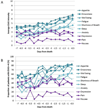Symptom Expression in the Last Seven Days of Life Among Cancer Patients Admitted to Acute Palliative Care Units
- PMID: 25242021
- PMCID: PMC4366352
- DOI: 10.1016/j.jpainsymman.2014.09.003
Symptom Expression in the Last Seven Days of Life Among Cancer Patients Admitted to Acute Palliative Care Units
Abstract
Context: The symptom burden in the last week of life of patients with advanced cancer has not been well characterized.
Objectives: To examine the frequency, intensity, and predictors for symptoms in the last seven days of life among patients who were able to communicate and died in an acute palliative care unit (APCU).
Methods: We systematically documented the Edmonton Symptom Assessment System (ESAS) daily and 15 symptoms twice daily on consecutive advanced cancer patients admitted to APCUs at MD Anderson Cancer Center (U.S.) and Barretos Cancer Hospital (Brazil) from admission to death or discharge in 2010/2011. We examined the frequency and intensity of the symptoms from death backward.
Results: A total of 203 of 357 patients died. The proportion of patients able to communicate decreased from 80% to 39% over the last seven days of life. ESAS anorexia (P = 0.001 in longitudinal analyses), drowsiness (P < 0.0001), fatigue (P < 0.0001), poor well-being (P = 0.01), and dyspnea (P < 0.0001) increased in intensity closer to death. In contrast, ESAS depression (P = 0.008) decreased over time. Dysphagia to solids (P = 0.01) and liquids (P = 0.005) as well as urinary incontinence (P = 0.0002) also were present in an increasing proportion of patients in the last few days of life. In multivariate analyses, female sex, non-Hispanic race, and lung cancer were significantly associated with higher ESAS symptom expression (odds ratio > 1).
Conclusion: Despite intensive management in APCUs, some cancer patients continue to experience high symptom burden as they approached death.
Keywords: Anorexia; death; deglutition disorders; depression; dyspnea; neoplasms; pain; palliative care; symptom assessment; urinary incontinence.
Copyright © 2015 American Academy of Hospice and Palliative Medicine. Published by Elsevier Inc. All rights reserved.
Conflict of interest statement
All authors report no relevant financial conflicts of interest
Figures



References
-
- Seow H, Barbera L, Sutradhar R, et al. Trajectory of performance status and symptom scores for patients with cancer during the last six months of life. J Clin Oncol. 2011;29:1151–1158. - PubMed
-
- Mercadante S, Casuccio A, Fulfaro F. The course of symptom frequency and intensity in advanced cancer patients followed at home. J Pain Symptom Manage. 2000;20:104–112. - PubMed
Publication types
MeSH terms
Grants and funding
LinkOut - more resources
Full Text Sources
Other Literature Sources
Medical

